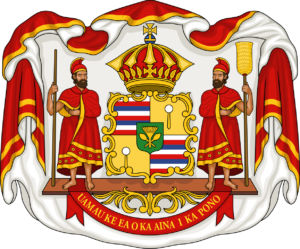dynastic orders
kingdom of Hawaii
The Kingdom of Hawaii, originated in 1795 when the warrior chief Kamehameha the Great, of the independent island of Hawaii, conquered the independent islands of Oahu, Maui, Molokai, and Lānaʻi and unified them under one government. In 1810, the whole Hawaiian archipelago became unified when Kauai and Niʻihau joined the Hawaiian Kingdom voluntarily. Two major dynastic families ruled the kingdom: The House of Kamehameha and the House of Kalakaua, both being descended from the powerful Royal House of Keawe.
History of the kingdom
The Kingdom of Hawaii, originated in 1795, when the warrior chief Kamehameha the Great, of the independent island of Hawaii, conquered the independent islands of Oahu, Maui, Molokai, and Lānaʻi and unified them under one government. In 1810, the whole Hawaiian archipelago became unified when Kauai and Niʻihau joined the Hawaiian Kingdom voluntarily. Two major dynastic families ruled the kingdom: The House of Kamehameha and the House of Kalakaua.
It is believed the first inhabitants of Hawaii may have reached the islands as early as the year 300 from the Marquesas Islands. Contact with and settlement by Tahitians began in the 9th century. Powerful classes of chiefs and priests arrived and established themselves but became embroiled in conflicts that were similar to the feudal struggles in Europe, with complicated land rights at the center of the disputes. Early Hawaiians culture was entirely oral and rich in myth, legend, and practical knowledge, especially of animals and plant life. The material life of the islands was hampered by the lack of metal, pottery, or beasts of burden, but there was great skill in the use of wood, shell, stone, and bone, and the huge double and outrigger canoes were technical marvels. Navigational methods were well developed, and there was an elaborate calendar. Athletic contests encouraged warrior skills.
Arrival of europeans
Captain James Cook, the British explorer and navigator landed at Waimea, Kauai Island, on January 20, 1778. Upon his return the following year, he was killed during an affray with a number of Hawaiians at Kealakekua Bay.
The initial appearance of Cook was followed by a period of intermittent contact with the West. In 1795, King Kamehameha I using European military technology and weapons, conquered the independent islands of Oʻahu, Maui, Molokaʻi, and Lānaʻi, and unified them under one government. He is recognized as one of the most famous leaders in Hawaiian history.
For 85 years thereafter monarchs ruled over the Hawaiian kingdom, which was recognized by several European nations. The United States became its chief trading partner and watched over it to prevent some other power from threatening to seize control.
Hawaii was forced to adopt a new constitution in 1887 when King Kalākaua was threatened with violence by the Honolulu Rifles, a white anti-monarchist militia, to sign it. Queen Liliʻuokalani, who succeeded Kalākaua in 1891, tried to abrogate the 1887 constitution and promulgate a new constitution but was overthrown in 1893, largely at the hands of the Committee of Safety, a group of residents consisting of Hawaiian subjects and foreign nationals of American, British, and German descent. Hawaii became a republic until it was annexed by the United States. Hawaii became a territory of the United States in 1900. It later became a state in 1959.
illegal occupation
United States Public Law 103-150 adopted in 1993 acknowledged that he overthrow of the Kingdom of Hawaii occurred with the active participation of agents and citizens of the United States and that the Native Hawaiian people never directly relinquished to the United States their claims to their inherent sovereignty as a people over their national lands, either through the Kingdom of Hawaii or through a plebiscite or referendum.
"Joint Resolution Nov 23, 1993 to acknowledge the 100th anniversary of the January 17, 1893 overthrow of the Kingdom of Hawaii, and to offer an apology to Native Hawaiians on behalf of the United States for the overthrow of the Kingdom of Hawaii”. Furthermore “The Congress of the United States- on the occasion of the 100th anniversary of the illegal overthrow of the Kingdom of Hawaii on January 17, 1893, acknowledges the historical significance of this event which resulted in the suppression of the inherent sovereignty of the Native Hawaiian people"
United States Public Law 103-150
monarchs of hawaii
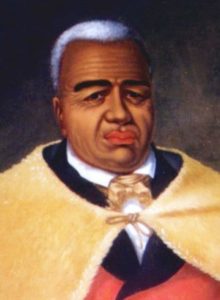
King Kamehameha I
Kamehameha I, original name was Paiʻea, byname Kamehameha the Great, (born November 1758, Kohala district, Hawaii island—died May 8, 1819, Kailua), Hawaiian conqueror and king who, by 1810, had united all the Hawaiian islands and founded the Kamehameha dynasty, the most-enduring and best-documented line of Hawaiian rulers, being from the powerful royal house of King Keawe of Hawaii.
First named Paiʻea, meaning “Hard-Shelled Crab,” A Hawaiian tradition tells that a bright star, Kokoiki, appeared just before the great conqueror was born. The date of the legend coincides with the appearance of Halley’s Comet in 1758. When Kokoiki was viewed by the kahunas, Hawaii’s mystic seers, it was prophesied that a great leader was about to be born who would defeat all his rivals and reign supreme over all the islands. .
Kamehameha’s father was Keouanui who was the son of the sacred and high ranking Keʻeaumokunui, being the son of King Keawe & his half sister, Queen Kalanikauleleiaiwi. Because of the royal blood of half siblings called Niau-Piʻo, he was considered the most sacred of all the children of King Keawe. Although King Keaweʻs eldest son, Kalaninuiʻiamamao was the crown prince as he being the first born.
After King Keawe died, a feudal war broke out between the two brothers. Another half brother named Alapaʻi took advantage of the situation and killed the two princely brothers, becoming the usurper king, however, Alapaʻi took the slain brotherʻs sons, Kalaniopuʻu and Keouanui into his court. Kalaniopuʻu was the son of crown prince Kalaninuiʻiamamao and Keouanui was the son of the high ranking sacred Keʻeaumokunui.
Kamehamehaʻs mother was Kekuʻiapoiwa II, a niece of Alapaʻi. She had been betrothed to Keouanui since childhood as she was his sacred high ranking cousin. Upon the birth of their son Paiʻea, the infant prince was ordered to be put to death by Alapaʻi but was hidden and reared secretly, apart from anyone, being alone and trained specifically in warfare where he grew into manhood, taking the name Kamehameha, meaning “The Very Lonely One” or “The One Set Apart.”
After the death and short reign of the usurper King Alapaʻi, the slain crown princeʻs son Kalaniopuʻu took back his rightful throne becoming King and his successor was his son Kiwalaʻo. King Kalaniopuʻu’s cousin Keouanui was his own half brother and because of the spiritual high ranks and prophecies, Kalaniopu’u gave his war god Kukaʻilimoku to his nephew, Kamehameha.
At the death of King Kalaniopuʻu in 1782, the island of Hawaii was divided between his son, Kiwalaʻo, and his nephew, Kamehameha. Despite jealousy between the two cousins, relations were peaceful until July 1782, when a dispute between their chiefs at Keomo led to the outbreak of war. In the ensuing battle at Mokuohai, Kiwalaʻo was slain. Kamehameha then embarked upon a series of conquests that by 1795 had brought all the islands but Kauaʻi and Niʻihau under his control. When these were ceded to him through peaceful negotiations in 1810, Kamehameha was the undisputed ruler of the entire island group and became the first king of all Hawaiʻi.
Although autocratic in principle, Kamehameha set up governors to administer each island. He retained the traditional harsh kapu system of laws and punishments, but he also promulgated the mamalahoe kanawai, “the law of the splintered paddle,” which protected the common people from unduly brutal aggressions of powerful chiefs. He also outlawed human sacrifice, rites that had been performed in former times to increase the mana, or sacred power, of the king.
A shrewd businessman, Kamehameha amassed a fortune for his kingdom through a government monopoly on the sandalwood trade and through the imposition of port duties on visiting ships. He was an open-minded sovereign who rightfully deserves his title Kamehameha the Great. Acclaimed as the strongest Hawaiian ruler, he maintained his kingdom’s independence throughout the difficult period of European discovery and exploration of the islands—a task that proved too great for his successors.
King Kamehameha II
The second king of the Kingdom of Hawaii came to power at the age of 22. Born in 1797 as Liholiho he inherited the throne upon Kamehameha I’s death in 1819. However Queen Ka’ahumanu had intentions to rule the young kingdom herself.
As Liholiho arrived on the Big Island to claim the throne Ka’ahumanu greeted him wearing Kamehameha’s royal red cape and proclaimed “we two shall rule the land“. The young king, surprised, had no other choice. Liholiho died in 1825.
Kamehameha II (Liholiho) is best known for breaking the over 600 year old kapu (taboo) system of rule by sharing a meal with Ka’ahumanu and his mother Keopuolani. This began the disbanding of the social class of priest and the destruction of temples and idol imagery and carvings.
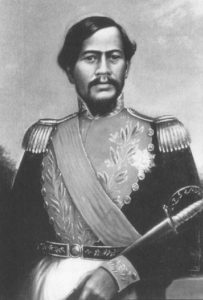
King Kamehameha III Reigned From 1825-1854
Prince Kauikeaouli was the son of Kamehameha I and his Consort, the High Chiefess Keopuolani, succeeding the throne from his brother, King Kamehameha II on June 6, 1825. His nephew, Prince Alexander Liholiho was his successor, taking the title of Kamehameha IV
In 1839 King Kamehamea III created a Royal Boarding School, founded as the “Chiefs Children’s School” ,situated where the State Capital of Hawai’i now stands. The school was created for the purpose of grooming the highest ranking chief’s children of the realm to be rulers. This ensured that the Hawaiian kingdom would continue through these ali’i who were entitled to rule by rank.
King Kamehameha III called on seven boys and seven girls of his family to board in the Chiefs Children’s School, and officially proclaimed them eligible for the throne under the Constitutional Laws of the Hawaiian Kingdom.
King Kamehameha IV Reigned From 1854-1863
Prince Alexander Liholiho was the Son of High Chief Mataio Kekuanaoa & Princess Kina`u (daughter of Kamehameha I), succeeding the throne from his uncle, Kamehameha III on December 15, 1854. His brother Prince Lot Kapuaiwa was his successor, taking the title of Kamehameha V
King Kamehameha V Reigned From 1863-1872
Prince Lot Kapuaiwa was the Son of High Chief Mataio Kekuanaoa & Princess Kina`u (daughter of Kamehameha I), succeeding the throne on November 30, 1863, after his brother, Kamehameha IV. He did not officially name an heir to the throne, which enabled the constitutional law to elect an ali`i by the legislature. The candidates were those of the highest rank who were proclaimed eligible to the throne by Kamehameha III and was groomed to be a ruler at the Chief’s Children’s School. The ali’i who won the election was William Lunalilo, a descendant from the brother of Kamehameha I
King Lunalilo Reigned From 1873-1874
High Chief Charles William Lunalilo was eligible to the throne by decree of Kamehameha III and was groomed at the Chiefs Children’s School, succeeding the throne on January 8, 1873 by election under constitutional law. He was the son of High Chief Charles Kana’ina & Princess Kekauluohi (niece of Kamehameha I). He also did not officially name an heir to the throne, which enabled the constitutional law to elect again an ali`i by the legislature. The candidates again were those of the highest rank who were proclaimed eligible to the throne by Kamehameha III. The ali’i who won the election was David Kalakaua
King Kalakaua Reigned From 1874-1891
High Chief David Kalakaua was eligible to the throne by decree of Kamehameha III and was groomed at the Chiefs Children’s School. He was the son of High Chief Kapa’akea & High Chiefess Keohokalole, descended from Keoua Nui’s cousins, Kame’eiamoku and Keaweaheulu. He succeeded the throne on February 13, 1874 by election under the constitutional law. His successor was his sister, Princess Lili’u Kamaka’eha taking the title of Lili’uokalani
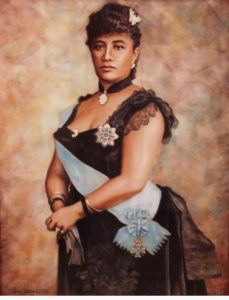
Queen Lili`uokalani Reigned From 1891-1893 (Sovereign under occupation until 1917)
Possibly no other Hawaiian Monarch was more beloved by the people than Queen Lili’uokolani. Her brother King Kalakaua began a revival of the Hawaiian culture which she was determined to continue.
Born into a high ranking Hawaiian family as Lydia Kamakaeha in 1838, her mother (Keohokalole) served as an advisor to King Kamehameha III. As was customary of the times, young members of the royal family like Lydia were educated by missionaries and traveled the Western world. When she was ten years old the boarding school she attended was closed as the result of a measles epidemic on O’ahu that took the lives of around 10,000 people, mostly native Hawaiians. Her three-year-old sister also died in the epidemic.
She spent time in the court of Kamehameha IV as Princess Kamaka’eha. She was married in 1862 at the age of 24 to the son of a ship captain named John Owen Dominus. He became an official in the Hawaiian government and later served as governor of O’ahu and Maui. The couple had no biological children but adopted (hanai) several.
Princess Kamaka’eha elder brother David was appointed to the throne in 1874 and her youngest brother William Pit Leleiohoku was named heir to the throne. When Leleiohoku died three years later, Princes Lydia Kamaka’eha was named heir apparent and received the title Lili’uokolani. She worked towards the creation of schools for Hawaii’s youth and acted as King Kalakaua’s regent during the King’s world tour in 1881.
In addition to her role as a monarch devoted to her country and people she was an important scholar and prolific musician and composer. She learned much on her travels abroad and became well versed with American and European composers as well as being an authority on traditional Hawaiian chants and songs. In her lifetime she composed more than 150 songs including her most famous “Aloha ‘Oe”.
After the death of her brother King Kalakaua in 1891 she ascending the throne and became Queen Lili’uokolani. Her first order of business was to amend the Bayonet Constitution and restore the power to the monarchy and the Hawaiian people. The sugar planters and businessmen of the islands instigated an overthrow fearing loss of revenue and the influence of a popular Queen. They prompted the U.S Marines to march on Iolani Palace and forced the Queen to surrender the Hawaiian Kingdom to the United States in 1893. Acting as leader of the Stand Firm Movement she advocated against U.S annexation and in turn was imprisoned inside Iolani Palace for 8 months.
A provisional government was established and named the Republic of Hawai’i with Sanford B. Dole as president in 1894. A rebellion ensued that included Prince Jonah Kuhio but the Wilcox Rebellion failed and the group was captured with Prince Kuhio spending a year in jail. She staved off annexation for 4 years with support from U.S. president Grover Cleveland who believed Hawai’i should stay a sovereign nation. That support ended with the election of William McKinley who quickly annexed Hawai’i in 1898.
Living out the remainder of her later life as a private citizen, she established the Queen Liliʻuokalani Trust in 1909 for the care of orphaned and destitute children of Hawai’i. The Queen Liliʻuokalani Children’s Center exists today as part of her legacy.
Princess Elizabeth Keka`aniau La`anui Head of the Royal House From 1917-1928
High Chiefess Elizabeth Keka` aniau La` anui was eligible to the throne by decree of Kamehameha III. She was the daughter of High Chiefess Owana Kaheiheimalie & High Chief Gideon Peleioholani La`anui, the grand nephew of Kamehameha I. Elizabeth was the hereditary head of the royal house, the “de jure” sovereign of the Hawaiian kingdom after the death of her cousin, Queen Lili`uokalani on November 11, 1917 while still under an illegal occupation. Further rights, upon the empty throne in 1917, the Hawaiian kingdom’s constitution would enable to elect an ali`i and the only ali`i eligible to the throne in 1917 is the High Chiefess Elizabeth Keka` aniau La` anui. Elizabeth was groomed to be a ruler at the Chiefs Children’s School and publicly proclaimed her sovereign rights as head of the royal house of Hawai`i after the queen’s death.
Elizabeth named her heir and successor is her niece, Princess Theresa Owana Ka’ohelelani La’anui
Princess Theresa Owana Ka`ohelelani La`anui Head of the Royal House From 1928-1944
High Chiefess Theresa Owana Ka’ohelelani La’anui was the daughter of Chiefess Kamaikaopa (granddaughter of Keohokalole) and High Chief Gideon Ka’ilipalaki La’anui (brother of Princess Elizabeth Keka’aniau La’anui), she became the head of the royal house after the passing of Princess Elizabeth Keka’aniau La’anui in 1928, continuing her royal prerogatives, her dynastic rights as the “de jure” sovereign of the Hawaiian kingdom which was still under a prolonged illegal occupation. Her son, Prince Robert Keoua Kalanikupuapa`ikalaninui would become the head of the royal house.
Princess Helena Kalokuokamaile Wilcox Salazar Head of the Royal House From 1944 – 1988
Prince Robert Keoua Kalanikupuapa`ikalaninui Wilcox was the only son of Princess Theresa Owana Ka`ohelelani La`anui Wilcox, and her husband, the Honorable, Robert William Kalanihiapo Wilcox. Robert Keoua was to become the head of the royal house, unfortunately he died in 1934 at an early age of 41. His first child, Helena Kalokuokamaile became the head of the royal house after Princess Theresa’s death in 1944. She was head of the Royal House until 1988. Her daughter, Owana Ka’ohelelani Salazar succeeded her and became the head of the royal house in 1988
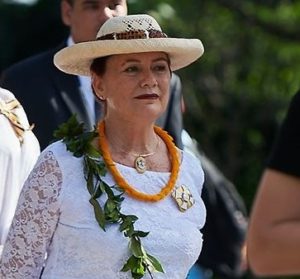
Princess Owana Ka`ohelelani La`anui Wilcox Salazar Head of the Royal House From 1988-present
HRH Princess Owana Ka’ohelelani La’anui Wilcox Salazar’s grandfather was the only son of HRH Princess Theresa Owana Ka’ohelelani La’anui, the primogeniture successor of HRH Princess Elizabeth Keka’aniau La’anui of the Kamehameha Dynasty.
HRH Princess Owana Ka’ohelelani La’anui Wilcox Salazar became head of the royal house after the death of her mother Princess Theresa Owana Ka’ohelelani La’anui in 1944 She continues the responsibilities of her royal prerogatives, “jura regalia” her dynastic rights as “de jure”, the right of the legitimate head of the royal house, possessing” fons honorum”, giving her the right to maintain royal titles and the right to appoint royal titles and honors, even under a deposed kingdom. Her son, HRH Prince Noa Kalokuokamaile III will succeed her.
Princess Owana is committed to recognizing great service to the Hawaiian nation, through the resumption of awarding membership in the Royal Order of the Crown, the first order of knighthood conceived for the Hawaiian Kingdom and thus the oldest. Princess Owana also intends to restore relationships with royal houses around the world, especially among those nations that recognized the independence of the Hawaiian Kingdom.
charitable interests
The Royal Household of Hawaii supports a diverse array of humanitarian programs, specifically cultural heritage, education, and the fight against homelessness, in an effort to ensure the well-being of all Hawaiians . Many of the Royal Households efforts are through the Kamehameha Foundation , an organization which promotes cultural and educational efforts as well as the fight to end homelessness. The Royal Household has a rich history in securing homes for the elderly as well as and building hospitals and schools for the people of Hawaii. This was done through the Ali’i Trusts. Today they support many organizations who’s mission is to provide help and support to the citizens of Hawaii. People interested in obtaining additional information or making a donation are encouraged to visit the Ali’i trust at https://www.crownofhawaii.com/foundations as well as the Kamehameha Foundation at https://www.kamehamehafoundation.org/.
Royal order of the crown of hawaii
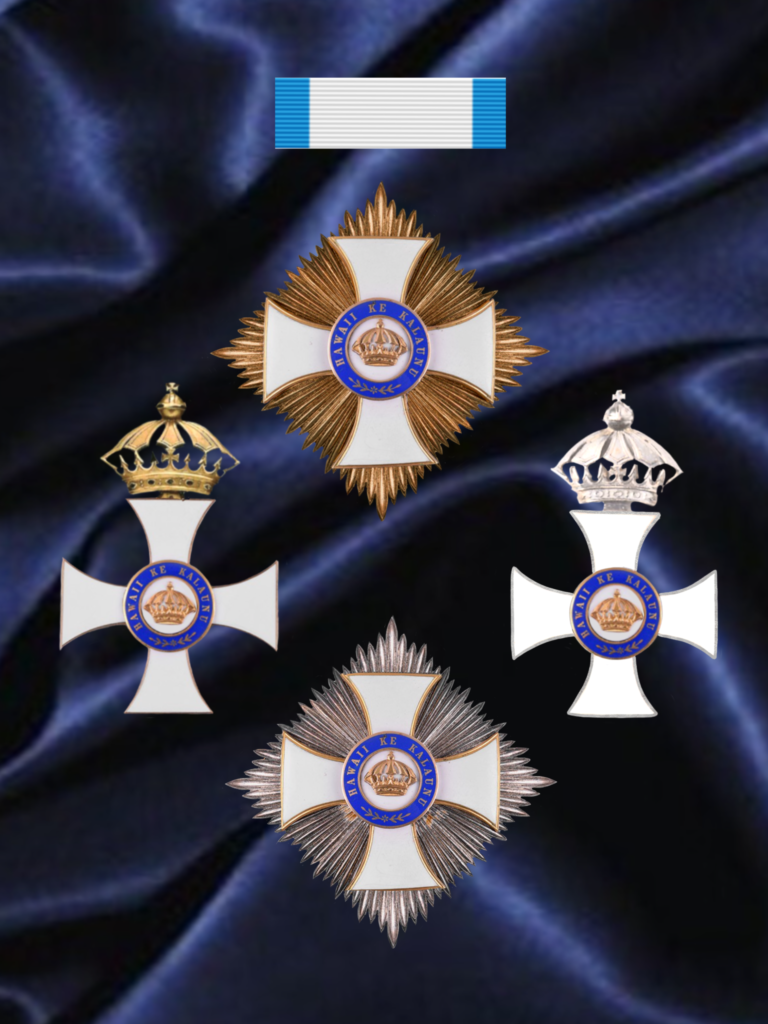
The Order was first introduced as the Order of the Cross and Crown in an Order-in Council of H.M. King Kamehameha III in July 1848, through his Minister for Foreign Affairs, Robert Wyllie. The statues of the Order, as the Order of the Crown of Hawaiʻi, were amended during the reign of H.M. King Kalākaua and awards of the Order continued. After H.M. Queen Liliʻuokalani was illegally deposed, the Order of the Crown was again held in abeyance. It has been re-established and amended in 2016 by HRH Princess Owana Ka`ohelelani La`anui Salazar, the “de jure” and “fons honorum” head of the royal house and Grandmaster of the order.
The revised 2016 order is modified with the ribbon color of gold with purple edges, the shield has a purple ring surrounding the Hawaiian crown with the motto “Onipa`a”.
The Order of the Crown is highly awarded to the head of states/dynasties, and as awards of merit to loyal supporters of the royal family and those who provide excellent services in the field of cultural achievement and education.
The order is awarded in five grades. They are:
Grand Cross/Cordon of the Royal Order of the Crown (GCRC) – Sash/Cordon Jewell (Neck Jewell), Gold Breast Star and Miniature with gold star on ribbon
Grand Officer of the Royal Order of the Crown (GORC)- Neck Jewell and Gold Breast Star and Miniature with two tone Gold and Silver star on ribbon
Knight Commander of the Royal Order of the Crown (KCRC)- Neck Jewell and Breast Star in Silver and Miniature with silver star on ribbon
Knight of the Royal Order of the Crown (KRC)- Neck Jewell and Miniature in gold (Nothing on ribbon)
Officer of the Royal Order of the Crown (ORC)- Neck Jewell and Miniature in silver
royal order of the cross of oceania
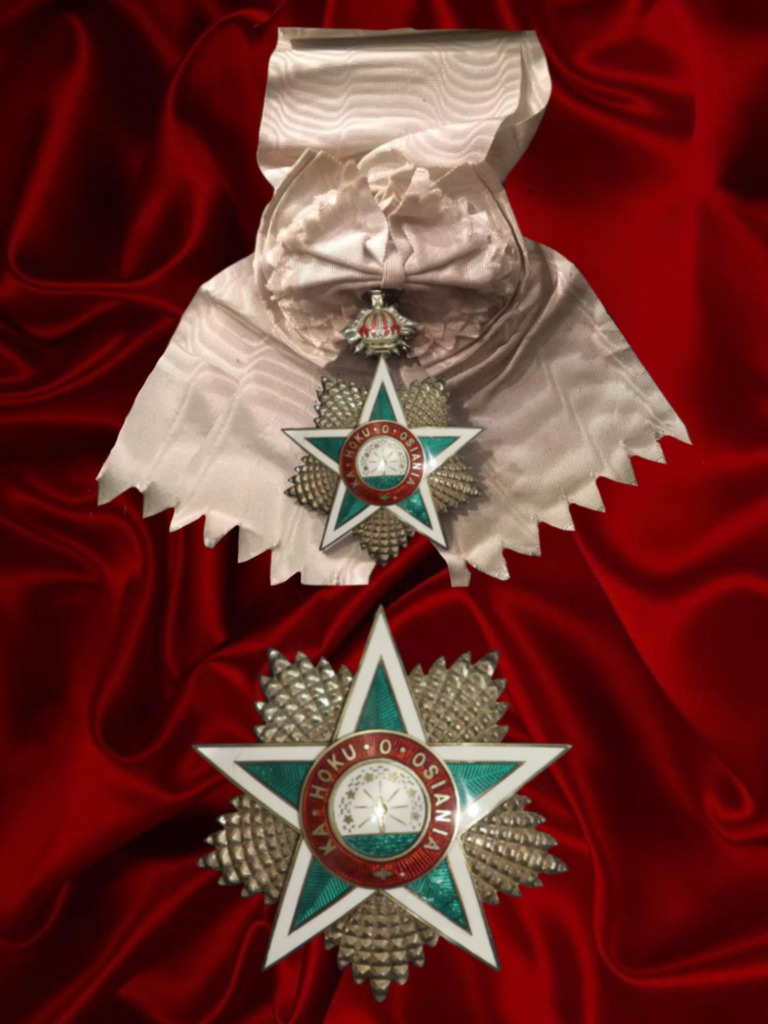
Breast Star and jewell of the order
The Royal Order of the Star of Oceania, founded by King Kalakaua I on 16th December 1886 for the recompense of distinguished services rendered in advancing his plan for a confederation of Polynesian nations, islands of the Pacific and Indian Oceans, and on contiguous Continents. In anticipation of Samoa joining the confederation, King Malietoa was awarded the Grand Cross.
Class of order: Grand Cross, Grand Officer, Commander, Officer, Companion, gold and silver medals
Re-established and amended by HRH Princess Owana Ka`ohelelani La`anui Salazar, the “de jure” and “fons honorum” head of the royal house and Grandmaster of the order.
The Royal Order of the Star of Oceania is awarded to the heads of state/dynasties, as an award of merit to loyal supporters of the royal family, and to those who provide excellent services in the field of cultural achievement and education throughout the Pacific.
This section was produced with the assistance and permission of the Chancellor of the Royal House of Hawaii, David Keali’maika’i Castro. Princess Owana Ka`ohelelani La`anui Wilcox Salazar , as the head of the Royal Household, is dedicated to providing humanitarian support to the people of Hawaii, as well to preserving the culture and traditions of a people dating to before the beginning of the kingdom. For more information on the Kingdom of Hawaii, the Dynastic Orders of the Royal Household, or to inquire about ways to donate support Her Royal Highness’ charitable activities, please visit the website of the Royal House of Hawaii at https://www.crownofhawaii.com
